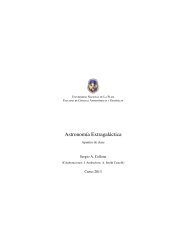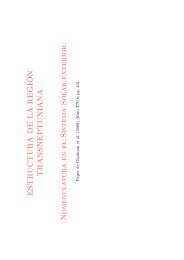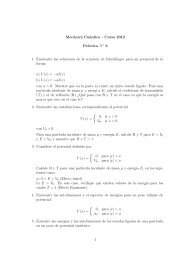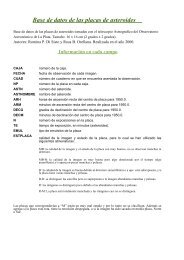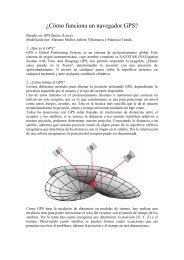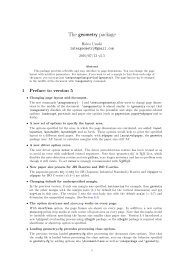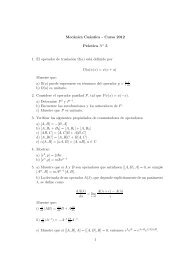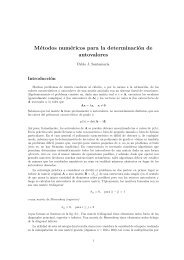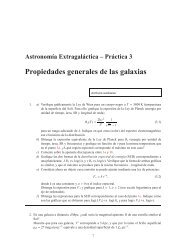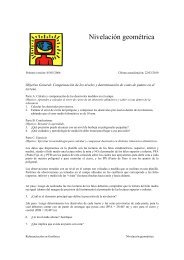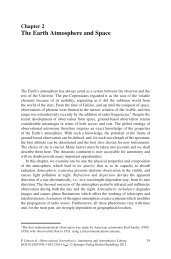Surface brightness profiles of dwarf galaxies in the NGC 5044 Group
Surface brightness profiles of dwarf galaxies in the NGC 5044 Group
Surface brightness profiles of dwarf galaxies in the NGC 5044 Group
Create successful ePaper yourself
Turn your PDF publications into a flip-book with our unique Google optimized e-Paper software.
412 S.A. Cellone: Dwarf <strong>galaxies</strong> <strong>in</strong> <strong>the</strong> <strong>NGC</strong> <strong>5044</strong> <strong>Group</strong>Fig. 5. Shape parameter vs. central surface <strong>brightness</strong> for <strong>NGC</strong> <strong>5044</strong><strong>Group</strong> <strong>dwarf</strong>s. The dashed l<strong>in</strong>es correspond to objects with constanteffective surface <strong>brightness</strong>es: S e =22, S e =23, and S e =24magarcsec −2 , as labeled. The three “outliers” are <strong>in</strong>dicated.<strong>pr<strong>of</strong>iles</strong> could be found. However, N42 has a normal effectivesurface <strong>brightness</strong> (for LSB <strong>dwarf</strong>s), still its shape is abnormalfor its lum<strong>in</strong>osity.B<strong>in</strong>ggeli & Jerjen (1998) used a l<strong>in</strong>ear comb<strong>in</strong>ation <strong>of</strong> centralsurface <strong>brightness</strong> (S 0 ) and log(N) to improve <strong>the</strong> correlationaga<strong>in</strong>st total magnitude. However, <strong>the</strong>y po<strong>in</strong>ted out thatnearly <strong>the</strong> same results were obta<strong>in</strong>ed us<strong>in</strong>g <strong>the</strong> relation betweeneffective surface <strong>brightness</strong> (S e ) and total magnitude. In fact, S eis a function <strong>of</strong> S 0 and N only (see Eq. 5), and has <strong>the</strong> advantage<strong>of</strong> be<strong>in</strong>g a “natural” comb<strong>in</strong>ation <strong>of</strong> <strong>the</strong>se parameters, <strong>the</strong>nnot depend<strong>in</strong>g on sample def<strong>in</strong>ition. Moreover, this relation is<strong>in</strong>dependent <strong>of</strong> Galactic ext<strong>in</strong>ction.Fig. 6 is a plot <strong>of</strong> S e(B) aga<strong>in</strong>st B T for Virgo and <strong>NGC</strong> <strong>5044</strong><strong>dwarf</strong>s, with <strong>the</strong> same cod<strong>in</strong>gs as Fig. 4. The dashed l<strong>in</strong>e is al<strong>in</strong>ear fit to <strong>the</strong> whole Virgo sample, and <strong>the</strong> dotted l<strong>in</strong>e is a fitto <strong>the</strong> subsample (half-filled triangles) formed with those Virgo<strong>galaxies</strong> that would have r e ≥ 6.8 ′′ at <strong>the</strong> distance <strong>of</strong> <strong>NGC</strong> <strong>5044</strong>.Both fits have fixed slope =1.0, because this is by def<strong>in</strong>ition<strong>the</strong> slope <strong>of</strong> <strong>the</strong> S e vs. V T relation when r e = constant (seeEq. 4). Here, <strong>the</strong> effect <strong>of</strong> distance on <strong>the</strong> distribution <strong>of</strong> observedeffective radii is even more dramatic than <strong>in</strong> Fig. 4.The solid l<strong>in</strong>e is a fit to <strong>the</strong> <strong>NGC</strong> <strong>5044</strong> <strong>Group</strong> data (filledcircles), exclud<strong>in</strong>g N42 and N51 (see below). It is evident thatafter <strong>the</strong> smaller <strong>dwarf</strong>s (affected by see<strong>in</strong>g) were elim<strong>in</strong>ated,most <strong>of</strong> <strong>the</strong> rema<strong>in</strong><strong>in</strong>g <strong>galaxies</strong> have similar effective radii (seeTable 4) <strong>the</strong>n produc<strong>in</strong>g a good correlation between S e and B T ,except for N42 and N51 which are larger and <strong>the</strong>n lie up and to<strong>the</strong> left <strong>of</strong> <strong>the</strong> mean relation. Aga<strong>in</strong>, a distance modulus betweenVirgo and <strong>the</strong> <strong>NGC</strong> <strong>5044</strong> <strong>Group</strong> can be derived, and <strong>the</strong>n used toredef<strong>in</strong>e <strong>the</strong> subsample, etc. This iterative procedure convergedto ∆(m − M) = 2.20 ± 0.08, <strong>in</strong> good agreement with <strong>the</strong>value ∆(m − M) =2.26 obta<strong>in</strong>ed by FS90 us<strong>in</strong>g <strong>the</strong> brightestcluster member method. With this relative distance, N42 andN51 would be larger than <strong>the</strong> largest <strong>dwarf</strong> <strong>in</strong> <strong>the</strong> Virgo sample,<strong>the</strong>n <strong>the</strong>ir exclusion is justified. This use <strong>of</strong> <strong>the</strong> effective surfaceFig. 6. Effective surface <strong>brightness</strong> (S e) vs. apparent blue magnitudesfor <strong>NGC</strong> <strong>5044</strong> <strong>Group</strong> and Virgo <strong>dwarf</strong>s. Cod<strong>in</strong>g is <strong>the</strong> same as for Fig. 4<strong>brightness</strong> vs. lum<strong>in</strong>osity relation as a distance <strong>in</strong>dicator is <strong>the</strong>nequivalent to match<strong>in</strong>g <strong>the</strong> mean effective radii <strong>of</strong> both samples.It is illustrative to note that, when compar<strong>in</strong>g <strong>the</strong> <strong>NGC</strong> <strong>5044</strong><strong>Group</strong> data with <strong>the</strong> CCD photometry <strong>of</strong> a sample <strong>of</strong> Virgo<strong>dwarf</strong>s from Durrell (1997) or <strong>the</strong> Fornax data from CFG, <strong>the</strong>iterative procedure just described fails because <strong>the</strong> nearby samplesalmost vanish after <strong>the</strong> first iteration. For this method towork, <strong>the</strong>n, <strong>the</strong> more distant cluster must be observed with <strong>the</strong>sufficient spatial resolution <strong>in</strong> order that objects with <strong>the</strong> same<strong>in</strong>tr<strong>in</strong>sic sizes are <strong>in</strong>cluded <strong>in</strong> both samples.6. ConclusionsIt is clear that <strong>the</strong> shape – lum<strong>in</strong>osity relation cannot be usedto derive distances to <strong>in</strong>dividual objects, at least until <strong>the</strong> situation<strong>of</strong> bright <strong>dwarf</strong>s with convex <strong>pr<strong>of</strong>iles</strong>, like N42 and N50,is understood. On <strong>the</strong> o<strong>the</strong>r hand, its use to derive mean relativedistances for groups <strong>of</strong> <strong>galaxies</strong> is severely hampered by<strong>the</strong> fact that its slope changes when objects <strong>of</strong> different <strong>in</strong>tr<strong>in</strong>siceffective radii are compared. This requires that samples with<strong>the</strong> same distribution <strong>of</strong> <strong>in</strong>tr<strong>in</strong>sic sizes must be observed, a goalthat is usually not easy to achieve. The data presented <strong>in</strong> thispaper for several <strong>NGC</strong> <strong>5044</strong> <strong>Group</strong> <strong>dwarf</strong> and <strong>in</strong>termediate lum<strong>in</strong>osityellipticals were compared to a specially selected sample<strong>of</strong> Virgo <strong>dwarf</strong>s, try<strong>in</strong>g to fulfill that condition. However,<strong>the</strong> relative distance obta<strong>in</strong>ed <strong>in</strong> this manner was significantlylower than all published values, suggest<strong>in</strong>g that a systematicdifference (maybe observational and/or environmental) is stillpresent between both groups <strong>of</strong> <strong>dwarf</strong>s. It is also worth mention<strong>in</strong>gthat, despite all <strong>galaxies</strong> with poor quality fits to <strong>the</strong>ir<strong>pr<strong>of</strong>iles</strong>, along with evident outliers, were elim<strong>in</strong>ated, rema<strong>in</strong><strong>in</strong>g<strong>the</strong>n only <strong>dwarf</strong>s with good quality CCD <strong>pr<strong>of</strong>iles</strong>, <strong>the</strong> scatter<strong>of</strong> <strong>the</strong> L − N relation rema<strong>in</strong>s relatively high, and this cannotbe assigned to a depth effect, given <strong>the</strong> small size <strong>of</strong> <strong>the</strong> <strong>NGC</strong><strong>5044</strong> <strong>Group</strong> as compared to <strong>the</strong> Virgo Cluster.A relative distance between <strong>the</strong> two groups <strong>in</strong> good agreementwith published values is obta<strong>in</strong>ed with <strong>the</strong> known lum<strong>in</strong>osityvs. effective surface <strong>brightness</strong> relation. However, given <strong>the</strong>



